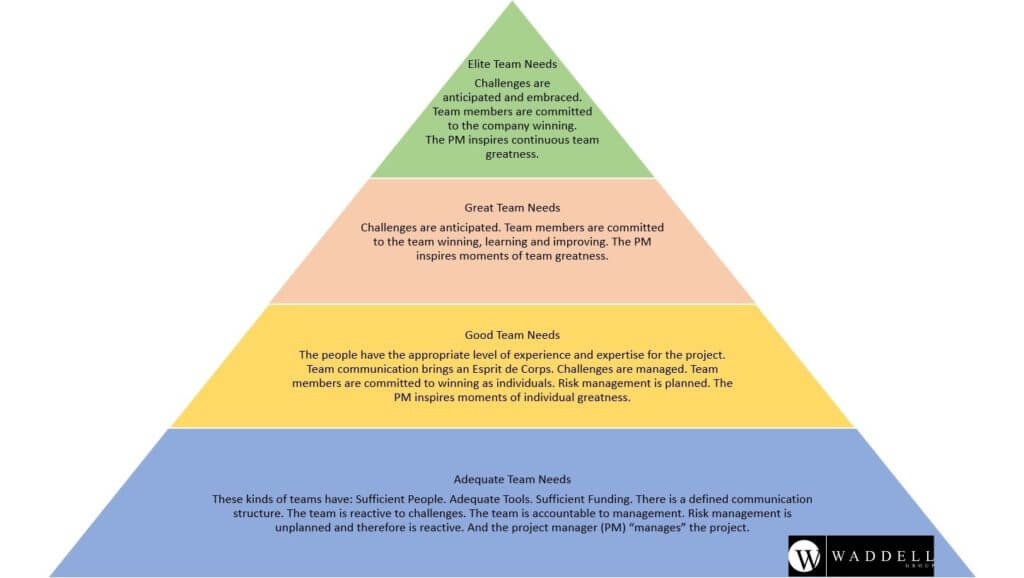
A project is as successful as the team managing it. And when you are in the medical device space, there is a level of competence and intelligence that you expect from every member of your team. The stronger the project team, the more successful the medical device project. Which begs the question, ‘How do you put together and manage a highly successful project team?’
- How do you select the right team members who can work together?
- How do you select the right medical device project manager for your project team?
- How do you determine whether a project is a good fit for the team and vice versa?
Read on to find out.
Here’s How You Can Put Together And Manage A Highly Successful Medical Device Project Team
1. Be aware of the hierarchy of teams.
As a group of experienced medical device project managers and project management consultants, we have identified the equivalent of Maslow’s hierarchy of needs – but for project teams.
Based on the observations of the Waddell group, there are four levels at which a project team operates. The level at which your project team executes their medical device project depends on:
- The degree of talent the team has, individually and collectively.
- How the project team deals with challenges and risks.
- What kind of medical device project manager oversees the project, and do how they motivate the team.
The levels of project teams are Adequate, Good, Great, and Elite. The infographic below explains what kind of teams you’ll find at each level.

Only by fulfilling the basic level of team needs (Adequate team needs) can one move on to the subsequent levels, all the way to the top (Elite team needs).
It is upto the medical device company to be aware of this hierarchy of teams and delegate projects accordingly.
2. Identify individuals who can be great team members.
While we like to place the responsibility for a medical device project’s success or failure on the project leader, every team member has ownership and influence on how a project turns out. A medical device project can only be highly successful if every individual on the team makes a positive contribution to it.
You can identify great team members by keeping an eye out for the following characteristics:
- Integrity. They hold themselves accountable for their thoughts, actions, and results.
- Strong communication skills help them effectively communicate with other team members and the project manager for a successful project.
- Adaptability to handle change and even thrive when it arrives.
- Respect for their work, company, and team members.
- Positive attitude towards making the team look great and ensuring that the project is successful.
- Ability to learn with every experience and every project they work on.
3. A highly successful project team has a project manager who knows just how to manage each member of the team.
To effectively manage a successful medical device project team, a project manager must be very aware of their team’s strengths, weaknesses, and personalities. They need to ask themselves how to manage every member of their team.
Some team members are only effective when given constant attention. Whereas others are driven by independent accomplishments and do not want to see the team leader regularly. Some team members fall in between the two. Whatever the case, it’s possible to help each member without micromanaging them.

4. Be cautious with your superstars.
The fact that your team can design, manufacture, and put a product through FDA testing means they have above-average intelligence and capability. With that said, we also know there are some people who see through to a solution immediately, while the rest of us have to work through problems and conundrums to reach there. They are the superstars of the team.
Sometimes, these superstars can be a cancer instead of a solid contributor to the team. They may be too inflated by their own importance to play well with the others. That’s why its necessary to keep an eye out for them and treat them with caution. For any exceptional talent who works on a team must be able to play well with others, be held to the same standards as each member of the team, and be willing, and even eager, to have their solutions challenged.
5. Remove the wrong fit team member from the medical device project team.
A member of your project team is not coming up to scratch. You’ve done everything in your power to help them be the right fit for the medical device project and the team. But you do not see any significant changes. While challenging, sometimes the only choice you can make as a medical device project manager is to remove them from the project team. But before you take that irreversible step of removing a team member from your project, you need to be clear on these three things:
- Determine if removing a team member is the right step.
- Have a solid reason for removing a team member from a medical device project.
- Understand how you can remove a team member from a project while mitigating the associated risk.
More on that here.
Are you a medical device company that wants to put together and manage a highly successful project team of your own?
Reach out. The Waddell group provides strategic level project leaders for the medical device industry. Beyond essential project management skills, our highly experienced consultants know how to lead teams, manage in times of crisis, and influence change. We offer expertise other firms can’t.
